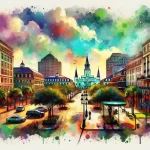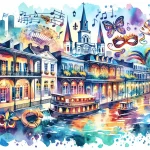St. Claude Avenue, a lively corridor extending from the Marigny neighborhood to the Lower Ninth Ward, is a cultural hub in New Orleans. This eclectic street has experienced a remarkable transformation, emerging as a center for art, music, and culinary delights that reflect the city’s diverse heritage.
In This Article
TL;DR
- St. Claude is a distinctive cultural district within New Orleans, offering a diverse range of attractions and activities.
- Key highlights include local art galleries, music venues, and acclaimed eateries that showcase the city’s culinary fusion.
- The area plays a crucial role in preserving and promoting New Orleans’ cultural landscape, making it a must-visit destination.
Historical Context of St. Claude
St. Claude Avenue has a rich history dating back to the early days of New Orleans. Originally an offshoot of North Rampart Street, it served as a gateway to the city’s outskirts, connecting the French Quarter to the surrounding neighborhoods and plantations.
The district’s cultural evolution was shaped by significant historical events, including the influx of artists and new residents following Hurricane Katrina. This revitalization transformed St. Claude into a thriving creative community, breathing new life into the once-neglected street.
Cultural and Artistic Highlights of St. Claude
Art Galleries and Museums
St. Claude is a true haven for art enthusiasts, boasting a vibrant local arts scene that spans various mediums. The street is adorned with captivating street art, including the iconic “The Third Line” mural, a 150-foot-long homage to the city’s second line culture.
Art galleries like the Antenna Gallery and the Rosewood Collective showcase the works of local and emerging artists, offering a glimpse into the diverse creative talents that call St. Claude home.
The Backstreet Cultural Museum and the Southern Food and Beverage Museum (SoFab) are cultural institutions dedicated to preserving and celebrating the city’s rich heritage. From Mardi Gras Indian suits to exhibits on Southern cuisine, these museums provide an in-depth exploration into the traditions that shape New Orleans’ identity.
Culinary Journey Through St. Claude
St. Claude is a foodie’s paradise, offering a tantalizing fusion of flavors that reflect the city’s diverse culinary influences. From Creole and Cajun classics to innovative fusion cuisines, the district’s eateries are a testament to New Orleans’ love for good food.
Fusion Flavors and Local Favorites
Morrow’s, a Black-owned restaurant, serves up a unique blend of Creole and Korean flavors, while Fritai offers a taste of Haitian street food, showcasing the deep connections between New Orleans and the Caribbean.
For those seeking a quintessential New Orleans experience, St. Roch Market is a must-visit. This historic food hall features rotating vendors serving up everything from beignets to po-boys, ensuring there’s something to satisfy every craving.
Music and Entertainment in St. Claude
Music is the heartbeat of New Orleans, and St. Claude is no exception. The district is home to a variety of music venues that celebrate the city’s rich musical heritage.
Live Music and Entertainment
Dive bars like Kajun’s and Hi-Ho Lounge offer lively atmospheres where locals and visitors alike can enjoy live music and karaoke nights. The AllWays Lounge & Cabaret is a hub for burlesque, drag shows, and variety acts, showcasing the city’s vibrant LGBTQ+ community.
Annual festivals like the Congo Square Rhythms Festival and NOLAxNOLA celebrate the deep history of Congo Square and the city’s local musicians, respectively, making St. Claude a prime destination for music lovers.
Architectural and Historical Landmarks
St. Claude is a treasure trove of architectural gems that tell the story of New Orleans’ past. From historic shotgun houses to grand mansions, the district’s buildings reflect the city’s diverse cultural influences and architectural styles.
Preserving History and Culture
The Lower Ninth Ward Living Museum is a poignant reminder of the resilience of the community, offering exhibits and oral histories that shed light on the neighborhood’s rich history and the impact of Hurricane Katrina.
Preservation efforts by organizations like the Friends of the Cabildo aim to protect and maintain the district’s historic landmarks, ensuring that St. Claude’s architectural heritage remains a source of pride for generations to come.
Address: 339 Chartres St, New Orleans, LA 70130
Phone: (504) 523-3939
Hours: Tuesday-Sunday 10AM-4:30PM
Community and Lifestyle
St. Claude is more than just a destination; it’s a vibrant community where residents embrace a unique lifestyle that blends tradition and modernity. The district’s daily rhythms are shaped by local initiatives and community projects that foster a sense of belonging and pride.
From neighborhood gardens to art collectives, St. Claude’s residents are actively engaged in shaping the district’s future, ensuring that its cultural identity remains intact while embracing new ideas and perspectives.
Visitor’s Guide to St. Claude
Exploring St. Claude is an immersive experience that requires a bit of preparation. The best times to visit are during the district’s annual festivals and events, when the streets come alive with music, food, and celebration.
Local tours offered by organizations like the Friends of the Cabildo provide an in-depth exploration of the district’s history and cultural significance, offering visitors a chance to experience St. Claude through the eyes of knowledgeable guides.
When it comes to accommodations, visitors can choose from a variety of options, ranging from charming bed and breakfasts to boutique hotels that capture the essence of New Orleans’ unique charm.
Economic Impact and Future Prospects
St. Claude’s cultural significance extends beyond its artistic and culinary offerings. The district plays a vital role in the economic landscape of New Orleans, attracting visitors and supporting local businesses.
Recent developments, such as the revitalization of the St. Roch Market and the opening of new galleries and eateries, have breathed new life into the district, creating job opportunities and fostering economic growth.
As St. Claude continues to evolve, it faces both challenges and opportunities. Gentrification and rising property values threaten to displace long-time residents, while new initiatives aim to strike a balance between preserving the district’s cultural identity and embracing sustainable growth.
With its rich history, vibrant community, and unwavering spirit, St. Claude remains a shining example of New Orleans’ resilience and cultural diversity, offering visitors and locals alike a chance to experience the city’s unique charm and embrace its enduring legacy.






